It is especially important with gutters. I've seen huge property damage because of failing drainage in the gutters, and I'm not even talking about the swarms of mosquitoes! Scholastic read right there, thanks!
Gena
Blog Post
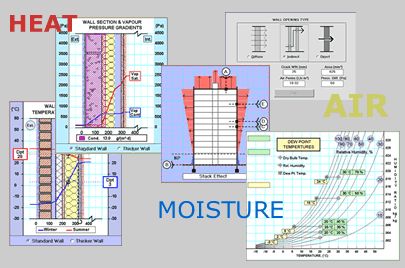
[Editor's note: Robert Riversong, a Vermont builder, continues his 10-part series of articles taking design and construction to what he sees as radical or "root" concerns. Enjoy--and please share your thoughts. – Tristan Roberts]
Hygro-thermal engineering is the analysis and management of the flows of heat (energy), air and moisture (mass) around, inside of, and through a building envelope. As such, it deals with the dense material (earth), the diffuse material (air), the transformative energy (fire) and the fluid medium (water)--and is a form of alchemy, which was the precursor to modern science and philosophy as well as foundation of the hero's journey from a leaden youth to a golden maturity.
Given how complex we've made our modern residential structures, it takes a hero to delve sufficiently into the mysteries of physics to confront and overcome the adversaries of heat, air and moisture and to transmute them into allies. Or, to be more mundane, the task facing every designer and builder of a modern home is to incorporate nature's inexorable laws into every stage of residential engineering--from conception, through design, by way of planning, toward final manifestation, occupancy and maintenance.
We live on a watery planet. Water is the most common "stuff" in the universe, the most abundant material on earth, and the sine qua non of life. Water is the only terrestrial substance that naturally occurs in solid, liquid and gaseous phases, it is essential for photosynthesis, metabolism and the thermo-regulation of our bodies and the earth's climate. In its solid form, it is less dense than as a liquid (so ice floats and allows aquatic life to survive the winter). Water has an abnormally high melting point, which allows liquid water to cover the earth and create a breeding ground and habitat for life.
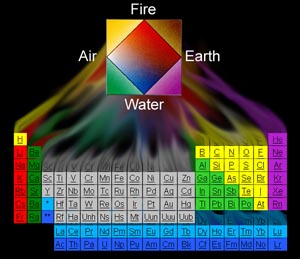
BuildingGreen relies on our premium members, not on advertisers. Help make our work possible.
See membership options »Water has the highest specific heat of all liquids except ammonia, which facilitates heat transfer in the atmosphere and oceans and moderates temperature extremes. Water has exceptionally high surface tension, which allows drop formation and rain as well as capillary movement within plants and trees as tall as 400 feet. Water absorbs infrared and ultraviolet light, which encourages photosynthesis and regulates atmospheric and oceanic temperatures. Water is an excellent solvent for ionic salts and polar molecules (the universal solvent), which facilitates the transfer of nutrients in metabolism and in hydrologic cycles from the mountains to the sea. Water has the highest heat of vaporization and the highest thermal conductivity of any liquid (except for liquid metals).
As we might remember from school, a water molecule is composed of two hydrogen atoms in a covalent (electron-sharing) bond with one oxygen atom, thus creating an electrical dipole with positive hydrogen charges that bond strongly to solids and to electrically-charged (ionized) materials. The hydrogen bonds keep liquid water strongly cohesive, with high surface tension that creates a "skin" on top that spiders can walk upon and that forms spherical droplets when it falls. That surface tension--coupled with water's strong bonding to solids--creates the capillary action that allows water to climb magically in narrow channels against gravity.
Water's high heat of vaporization--the energy required to break the hydrogen bonds and overcome atmospheric pressure--gives it a great deal of latent (or enthalpic) heat which is given up to its environment upon condensation (which is why fog melts snow faster than warm air, rain or sunshine). This latent heat is lost when warm, moist air leaves a conditioned space in the winter and puts an enormous load on an air conditioner in the summer because cooling below the dew point requires that the additional heat of condensation be removed from the air as well.
Water is always doing its dance. It moves continuously from solid to liquid to vapor and from absorbed bound states to desorbed free states. In other words, condensation is not something that happens only at the dew point--it is just more noticeable then.
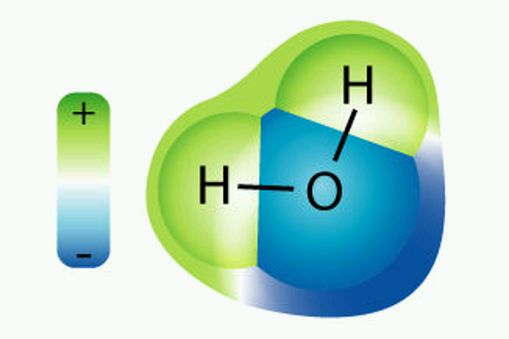
Humidity (or absolute humidity) is the mass of moisture in a volume of air (lbs per cubic foot), at a specific temperature and pressure. The mixing ratio (or specific humidity) is the mass of moisture in a given mass of air, and it determines the partial pressure of the water vapor – what we call vapor pressure. And vapor pressure is what drives water vapor diffusion. Relative humidity (RH), is the ratio of water vapor in air compared to the maximum it can hold at that temperature at saturation (100% RH). If half of the saturation volume is present, then the RH is 50%.
However, the curve of the amount of water vapor that air can hold as it increases in temperature is superlinear, such that--at a fixed absolute humidity--the RH will decrease by half with every 20° rise in air temperature. This also means that warmer air can hold an ever-increasing amount of water vapor and has the potential of producing high vapor pressures even at relatively low RH.
Absorption is the bonding of liquid water in the pores of a hygroscopic or hydrophilic material. Adsorption is bonding of water as a thin film on the surface of a solid (internally or externally). The two processes are simply variants of generic sorption, and the reverse process is desorption. Sorption can occur with water in either the liquid or gaseous states, but once water vapor bonds to a solid it loses the energy and freedom of a gas molecule and bonds as a liquid. Once sorbed, energy input forces bulk or surface diffusion into or out of a porous solid--a process also driven by a concentration gradient. Thus moisture diffusion is moved by heat or relative humidity, since the higher the RH the more opportunity for water vapor to condense into a state of sorption. Hence the moisture content (MC) of a hygroscopic material depends largely on RH, and the MC determines the likelihood of mold or decay.
A family of four will contribute 4–5 gallons of moisture per day from the normal activities of breathing, washing, bathing and cooking. A new house can release hundreds of gallons of water in the first year. A tight house can easily be overwhelmed by this moisture load, requiring both spot and whole-house ventilation, which is also necessary to maintain indoor air quality. But, even with indoor humidity controlled, moisture can intrude into the thermal or structural envelope from either inside or outside or from the ground.
Moisture intrusion requires a moisture source (atmospheric, interior, ground, mechanical or stored), a moisture mechanism (bulk movement, air movement, vapor diffusion, capillary action or condensation), a route of entry (gaps and penetrations, air permeable layers, vapor permeable layers or porous materials), and a driving force (kinetic energy, gravity, air pressure, vapor pressure, temperature gradient or surface tension). Moisture accumulation occurs when the rate of wetting exceeds (or is lagged by) the rate of drying and the difference exceeds the safe storage (buffering) capacity of materials. When moisture accumulation coincides with sufficient temperature and time, then problems occur--including mold, decay, rust, swelling, warpage, delamination, truss uplift, efflorescence, freeze-thaw damage, loss of thermal resistance, and insect infestation.
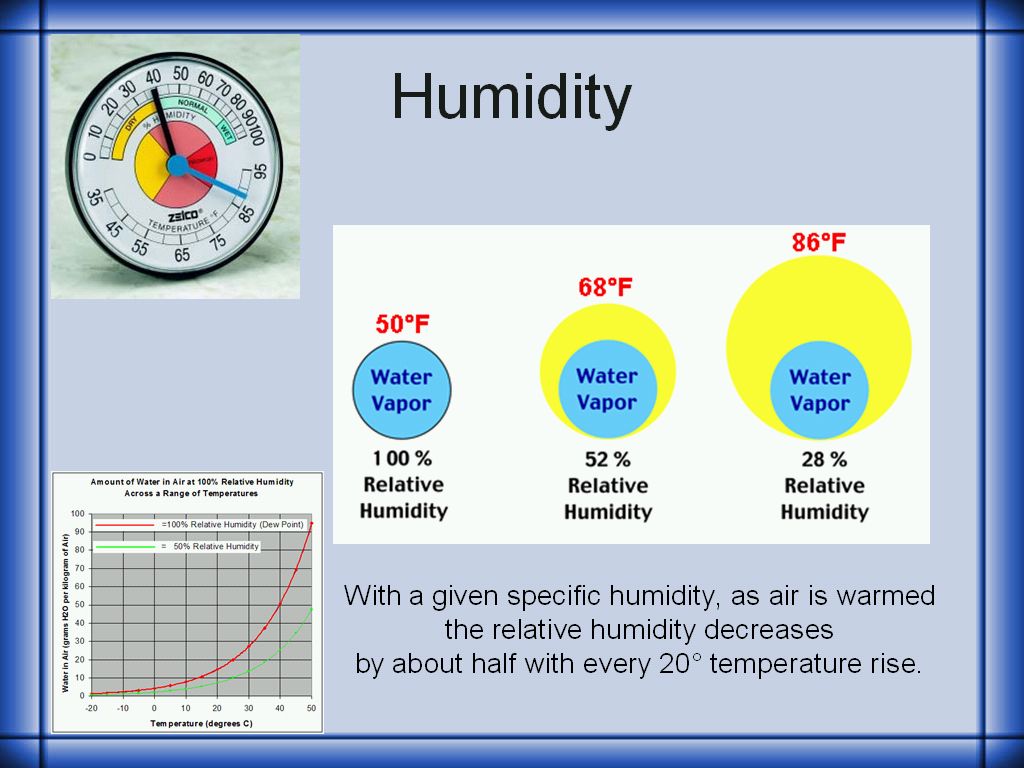
We have known for some time that moist air movement contributes as much as 100 times as much moisture to a thermal envelope as vapor diffusion through solid materials, so the focus today is on air barriers--both to prevent unnecessary heat loss or gain and to maintain the integrity and durability of the structure. In a cold climate, the dominant moisture drive (by both temperature and pressure gradients) is from inside to out--so it makes the most sense to locate the air (and vapor diffusion) barrier on the interior. The opposite is true in warm, humid climates where there air (and vapor diffusion) barrier should be on the outside. In mixed climates, moisture can move in either direction (and sometimes both at once), so take your pick. Except in the most extreme cold climates (zone 7 or 8), we no longer recommend true vapor barriers, since they are as likely to prevent drying as to reduce wetting (as the moisture drives reverse), but merely class II vapor retarders of about 1 perm (which can be accomplished with latex vapor retarder primer).
Of the various moisture mechanisms, bulk liquid flow and capillarity are the most significant, so careful exterior detailing and ground vapor barriers, capillary breaks and foundation waterproofing are the most important water management strategies. In fact, the four keys to moisture management are the four D's: deflection, drainage, drying and durable materials.
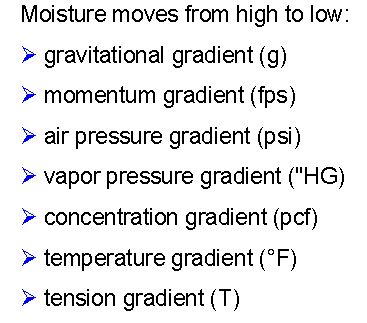
Deflection includes siting and landscaping to minimize exposure, roof overhangs and window sills, and lapped and integrated weather barrier, flashing and siding, and rainscreen claddings. Drainage encompasses site grading, sub-surface (French) drains, footing drains, roof gutters and downspouts, as well as rainscreens. Drying relies on vapor-open surfaces or rainscreens and sufficient moisture buffers to safely store daily or seasonal moisture until release. And durable materials include both moisture-tolerant elements as well as hygroscopic substances that can absorb and redistribute moisture, thereby reducing local concentrations (cellulose insulation is excellent at this).
What is not, in my natural-law abiding perspective, a sensible moisture management strategy is the use of impermeable materials, such as plastics, vinyl, bituthene and foams to create what I call the Hermetic House (hermetically sealed like a picnic cooler). One thing that we can be sure of is that every house will get wet at some point, and so a drying strategy can be more important than a waterproof approach. Every study that deliberately introduced a leak into either a wall or roof assembly concluded that drying was so significantly delayed by impermeable materials that damage was a certainty.
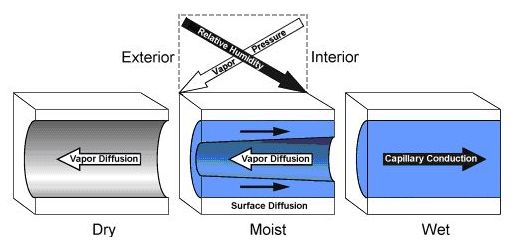
Another penny-wise but pound-foolish approach is the use of highly vulnerable materials like OSB. For exterior sheathing or roof decking I would never use anything other than CDX plywood or sawn boards (both of which are reasonably vapor-open). Similarly, I prefer #15 felt (ASTM D226, if possible) as a weather-resistant barrier (WRB) rather than the polymeric housewraps that can trap liquid water behind them and lose their water resistance because of surfactants in wood and stucco.
Just as I refuse to go to the extreme of designing or building a vapor-impermeable house, I also believe that air-tightness can be taken to an unnecessary and potentially dangerous extreme. With Passive House standards becoming the ideal for some designers, it is valuable to ask "How tight is tight enough?" The respected building scientist, John Straube, who has had the opportunity to test and observe thousands of houses in Canada's cold climates, has offered an answer that agrees with my own experience and wisdom. Homes with greater than 3 ACH50 (air changes per hour pressurized to 50 pascals with a blower door) tend to have a risk of interstitial condensation; those with greater than 5 or 6 ACH50 tend also to be too dry inside.
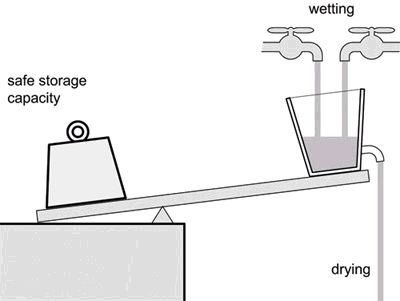
Those with about 2 ACH50 tend to perform quite well, while houses with as low as 1.5 ACH50 have problems with high winter indoor RH. This does not mean you cannot design and detail a 0.5 ACH50 Passive House to work well, but the more we go to extremes on any parameter, the more likely that unintended consequences will exact their revenge effects.
An ACH50 of 1.5 to 3 will also result in a natural air exchange rate of 0.1 to 0.2 ACH, which is just sufficient to maintain indoor air quality when the power is down or the mechanical systems are malfunctioning. To me, this allows a house to be fail-safe rather than allegedly fail-proof, and keeps it within the Golden Mean that Horace, Aristotle, Buddha, Confucius and Lao Tzu taught us to honor.
If a house is, indeed, our "third skin," then it must protect us without disconnecting us from the four elements of earth, air, fire and water which comprise our earthly abode, and it must honor the inherent mystical laws of nature's alchemy.
1. Context – land, community & ecology
2. Design – elegant simplicity, the Golden Mean
3. Materials – the Macrobiotics of building: natural, healthy and durable
4. Methods – criteria for appropriate technology
5. Foundations – it all starts here: how do we begin?
6. Envelope – shelter from the storm, our third skin
7. HVAC – maintaining comfort, health and homeostasis
8. Energy & Exergy – sources and sinks
9. Hygro-Thermal – the alchemy of mass & energy flow
10. Capping it All Off – hat & boots and a good sturdy coat
copyleft by Robert Riversong: may be reproduced only with attribution for non-commercial purposes
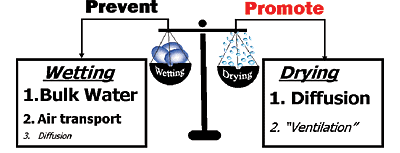
Robert Riversong has been a pioneer in super-insulated and passive solar construction, an instructor in building science and hygro-thermal engineering, a philosopher, wilderness guide and rites-of-passage facilitator. He can be reached at HouseWright (at) Ponds-Edge (dot) net. Some of his work can be seen at BuildItSolar.com (an article on his modified Larsen Truss system), GreenHomeBuilding.com (more on the Larsen Truss), GreenBuildingAdvisor.com (a case study of a Vermont home), and Transition Vermont (photos).
Published July 6, 2011 Permalink Citation
(2011, July 6). Water in Buildings: Part Science, Part Magic. Retrieved from https://www.buildinggreen.com/news-article/water-buildings-part-science-part-magic
It is especially important with gutters. I've seen huge property damage because of failing drainage in the gutters, and I'm not even talking about the swarms of mosquitoes! Scholastic read right there, thanks!
Gena
Actually, hydrogen is far from the most abundant thing in the Universe, since atoms make up only 4% of its total mass and only 15% of its total matter, with 85% being dark matter and the rest - 72% - being dark energy.
But, of the elements, hydrogen and oxygen (the components of water) are the first and third most abundant. Until 225 years ago, water was thought to be an indivisible element rather than a compound because of its unusual tenacity as a substance.
About 71% of the surface of the earth is covered by salt water oceans, while earth's poles are mostly covered with solid ice or sea ice. Water is ubiquitous on earth. The surface of the earth holds 324 million cubic miles of water, while the ground contains another 2 million cubic miles (36 times as much as on the dry land surface) and the atmosphere holds 3100 cubic miles more for a total of 326 million cubic miles. That's enough to cover the entire surface of the earth 1.65 miles deep with water.
Additionally, this year astronomers found a large water vapor cloud at the edge of the universe, orbiting a quasar 12 billion light years away from earth. The cloud holds a mass of water vapor that’s at least 140 trillion times that of all the water in the world’s oceans. “It’s another demonstration that water is pervasive throughout the universe, even at the very earliest times,” said Matt Bradford, a scientist at NASA’s Jet Propulsion Laboratory.
Umm... Water is nowhere near the most common thing in the universe. That would be hydrogen (H2) by a long shot. And water is not even the most common thing on earth.
Derek, That's the IECC climate zone system: http://tinyurl.com/5vccekr
"Except in the most extreme cold climates (zone 7 or 8)"
What climate zone system are you quoting? I couldn't find reference to one using a numbering system, where zone 7 was extreme cold.
Add new comment
To post a comment, you need to register for a BuildingGreen Basic membership (free) or login to your existing profile.